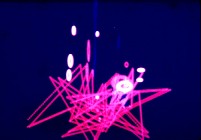

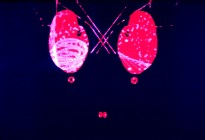

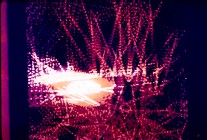

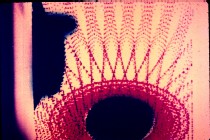
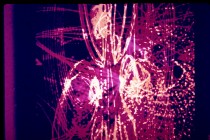

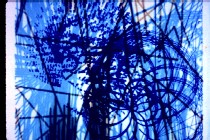

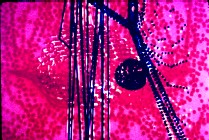
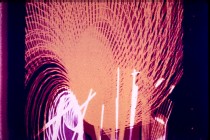


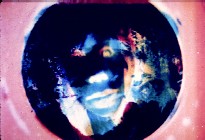
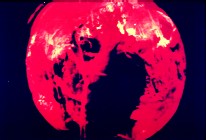

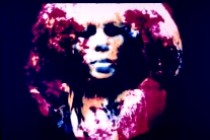
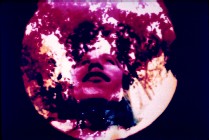

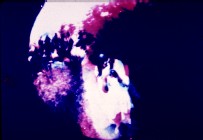




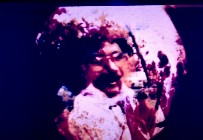


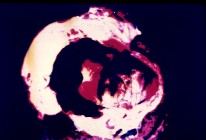
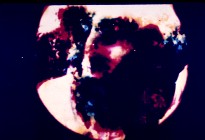
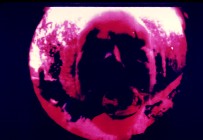
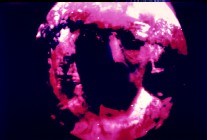
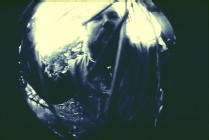
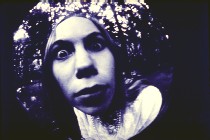
Miscellaneous still images from Cibernetik 5.3 (Los Angeles, 1960-65)
Computer generated images were recorded on 16 mm black and white high-contrast film as an approximately 7 mm square on a Sromberg-Carlson SC-4020 film recorder from over a dozen large magnetic tapes at General Dynamics in San Diego California. The digital images were intentionally compressed horizontally to provide for anamorphic expansion to a more conventional 1:1.8 motion picture format which did not become feasible with equipment available at that time. The 180 degree fish-eye footage was shot in black and white on a 16 mm Bell and Howell 70DL and colorized with the same process on a 16 mm Bell and Howell contact printer. Naturally close-ups were shot within just a few inches of anyone's face which results in extreme distortions. More recent information indicated that the Kodak color negative emulsions available during the 1960's and 70's were intentionally made at a lower quality, which would in fact gradually fade and loose its images, in order to lower film costs by a penny or so per foot. Slides of the motion picture frames were made in the 1960's with more stable dyes and digitized with a Minolta slide scanner at 1600 by 2400 pixel resolution, and shown above at about 9% of that resolution about 140 by 210 pixels in JPEG. The hyperlinked images associated to each small picture above is at 35% resolution in JPEG format at about 560 by 840 pixels.
Note: A few hyperlinks to high-resolution images may not work because the standard website at: tripod.com has to fit within 20 megabytes and so they were removed. The images here were scanned in 2002 on an early Minolta slide scanner from copies of slides made in the 1960's of 16mm frames from a print of the film.















The computer generated images in Cibernetik 5.3 were generated for a wide screen format, however the film recorder available in the early 1960's could only record a square image; consequently I had numerically compressed the images horizontally to allow for horizontal expansion later. Since this is a trivial task to horizontally stretch a JPEG image, I now took a small version of an image and cropped away the non-image portions to the left and the right, and then stretched the 140 by 189 element image to a 140 by 248 horizontal element image, which happened to be a 131% horizontal stretch, and which resulted in an image which was in the ratio of 1 to 1.77, which is the 16:9 standard. (Incidentally the program used was the very simple commonly available Microsoft Photo Editor which is adequate for all such still image manipulation.) Of course starting with the medium or high quality scan here would provide a sharper wide-screen result. Naturally the current telecine equipment that can convert 16 mm film to high definition television (1080 by 1920 progressive) would need to create almost 2 pixels from every scan line at the square center area which would also lead to a notable loss of sharpness; unless perhaps higher horizontal scan resolutions were used which may assist with image quality.
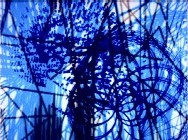

3:4 or 1:1.33 screen ratio, and the 9:16 or 1:1.77 screen ratio.
Home Images History Notes Algorithms Presentations
E-mail: info@cyberneticcinema.com, Web site: www.cyberneticcinema.com, © 2003 Cybernetic Cinema, updated Sunday, May 21, 2006 2:14 PM